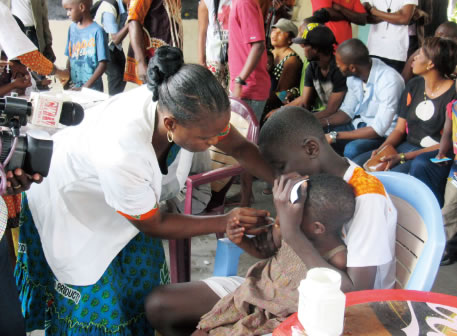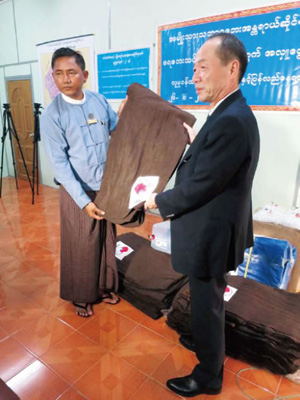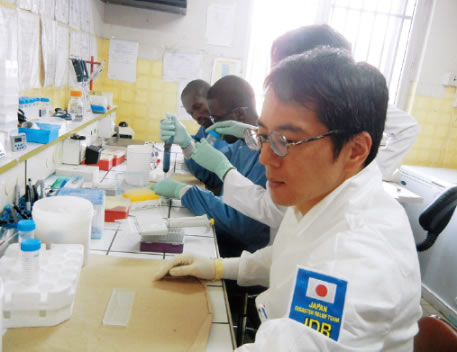(2) Emergency Humanitarian Assistance after Natural Disasters
Japan stands ready for immediate provision of emergency assistance in response to the request from the government of an affected country or an international organization when large-scale disasters occur overseas. As personnel assistance, there are five types of Japan Disaster Relief (JDR) Teams to provide humanitarian assistance: (i) Search and Rescue Team for search and rescue operations; (ii) Medical Team to provide emergency medical assistance; (iii) Infectious Diseases Response Team to implement measures to combat infectious diseases; (iv) Expert Team to give technical advice or guidance on emergency response measures and recovery operations; and (v) Self-Defense Force Unit to undertake medical activities, transportation of aid supplies and personnel when it is deemed particularly necessary in responding to large-scale disasters. The five types of teams are dispatched individually or in combination.
In-kind assistance is the provision of emergency relief goods. Japan stockpiles tents, blankets, and other goods needed for people affected in the immediate aftermath of a disaster, in four overseas warehouses. It enables Japan to quickly provide emergency relief goods to affected countries when disasters occur. In FY2015, Japan provided emergency relief goods for a total of 10 incidents in 9 countries, including Nepal, Myanmar, and Fiji.

Yellow fever vaccination campaign (Assistance in responding to the yellow fever outbreak in the Democratic Republic of the Congo) (Photo: JICA)
Moreover, for the purpose of providing relief to people displaced or affected by natural disasters and/or conflicts, Japan extends Emergency Grant Aid to the governments of affected countries as well as international organizations and other institutions that provide emergency assistance in areas affected by the disasters. In many cases, Japanese NGOs work as partners when these international organizations engage in actual emergency assistance. In FY2015, Emergency Grant Aid was extended through international organizations and other institutions mainly for humanitarian assistance to those affected by natural disasters in Nepal, Myanmar and other parts of Asia.
Additionally, Japanese NGOs provide various forms of assistance to those affected by disasters, whom government aid does not always reach, by utilizing ODA funds to meet their needs. Japan Platform (JPF), an international emergency humanitarian aid organization established through the partnership and cooperation of NGOs, business communities and the Government of Japan, dispatches member NGOs to provide assistance to refugees, IDPs, or people affected by conflict or natural disasters.
In FY2015, JPF provided humanitarian assistance for those affected by the earthquakes in Afghanistan and Pakistan, the floods in Myanmar, etc. JPF also set up a humanitarian assistance program following the April 2015 earthquake in Nepal in which JPF member NGOs provided assistance tailored to local needs mainly in mountainous areas where damages were extensive. Asia Pacific Alliance for Disaster Management, a disaster risk reduction cooperation network founded in Japan with extensive linkages with emergency humanitarian assistance NGOs and private sector organizations in five Asian countries, also utilized funds from the Government of Japan to conduct search and rescue activities as well as provide medical assistance and distribute food and other relief goods.
In July 2016, in order to respond to the yellow fever outbreak in the Democratic Republic of the Congo, Japan provided emergency grant aid of $3.5 million (approximately ¥371 million). In addition, Japan dispatched the JDR Infectious Diseases Response Team for the first time, and in cooperation with the Government of the Democratic Republic of the Congo and international organizations, such as WHO, the team offered advice to the local Ministry of Health officials, implemented technical assistance for laboratory diagnoses, prepared a mass vaccination campaign, etc.

Handover ceremony of emergency relief goods (blankets) provided in response to the flood damage in Myanmar (Photo: JICA)
In July 2015, Myanmar suffered extensive damage from torrential rains. Japan implemented grant aid worth a total of ¥5 billion for the rebuilding of schools and provision of water purifying vehicles and well-drilling equipment to contribute to the recovery and reconstruction effort in Myanmar. Furthermore, in May 2016 Japan decided to extend emergency grant aid worth approximately ¥300 million for the drought and saltwater intrusion damage in Viet Nam.
| Collaboration with International Organizations

The UN World Conference on Disaster Risk Reduction held in Sendai, March 2015 (Photo: UNISDR)
Japan cooperates with the Global Facility for Disaster Reduction and Recovery established in 2006 and managed by the World Bank. This Facility aims at supporting efforts to improve the ability for disaster risk prevention planning and post-disaster reconstruction in low- and middle-income countries that are vulnerable to natural disasters.
Against the backdrop of increased awareness of the importance of disaster risk reduction, representatives from countries all over the world and from international organizations such as the World Bank and UN agencies, which are involved in disaster risk reduction, gathered at a meeting of the UN General Assembly in 2006. At the meeting, the decision was made on the establishment of the Global Platform for Disaster Risk Reduction as a forum to facilitate discussions regarding disaster risk reduction. The first meeting of the Global Platform was held in June 2007. Japan proactively supports the activities of the United Nations Office for Disaster Risk Reduction (UNISDR), which serves as the secretariat for the Global Platform. In October 2007, UNISDR Hyogo Office was opened.
Since Japan has been proactively promoting international disaster risk reduction cooperation by utilizing its expertise and experiences, it served as the host country for the third conference in Sendai, following its hosting of the first conference in 1994 in Yokohama and the second conference in 2005 in Kobe. The third conference saw the adoption of the Sendai Framework for Disaster Risk Reduction 2015 – 2030 and the Sendai Declaration, which incorporates approaches proposed by Japan, including the importance of investment in disaster risk reduction, involvement of diverse stakeholders, and the concept of “Build Back Better,” within a new set of international guidelines on disaster risk reduction. In addition, Japan is also supporting the ASEAN Coordinating Centre for Humanitarian Assistance on Disaster Management (AHA Centre) by providing support for information communication systems and dispatching personnel as well as providing emergency relief goods and support for establishing a goods management and distribution system.
•Democratic Republic of the Congo
Yellow Fever Outbreak in the Democratic Republic of the Congo: Dispatch of the Japan Disaster Relief Infectious Diseases Response Team
Dispatch of the JDR Team and emergency grant aid (July 2016 – August 2016)

Technical assistance to test yellow fever (Photo: JICA)
In December 2015 there was an outbreak of yellow fever in Angola which is located in southwestern Africa, and since March 2016, suspected cases of yellow fever were identified in five provinces, including the special province of Kinshasa, the capital of the Democratic Republic of the Congo (hereinafter referred to as “the DRC”) which shares its border with Angola.
On July 19 2016, in response to a request from the DRC, Japan dispatched a Japan Disaster Relief (JDR) Infectious Diseases Response Team consisting of staff members from the Ministry of Foreign Affairs of Japan and JICA, as well as infectious diseases experts. The Infectious Diseases Response Team was established in October 2015 as a new form of the JDR Team, and this dispatch became its first mission.
The Infectious Diseases Response Team in cooperation with the Government of the DRC, WHO, etc. provided advice to top officials of the Ministry of Public Health in Kinshasa and also implemented technical support for running yellow fever tests and support for preparations for an immunization campaign, including recommendations for improvement. Among other things, the laboratory at the Institute National de Recherche Biomédicale (INRB) — the only testing and diagnostic institution in the DRC, which had suspended operating due to shortages of human resources, supplies and equipment — has managed to recommence operations with the support of this team. It was a significant accomplishment by the team that the testing of the samples which had been left undiagnosed was completed within July.
Furthermore, in addition to the personnel contribution by the Infectious Diseases Response Team, Japan provided emergency grant aid of $3.5 million (approximately ¥371 million) for supporting vaccination campaigns, preventative education activities, border control and other efforts through WHO, the International Federation of Red Cross and Red Crescent Societies (IFRC), and the International Organization for Migration (IOM).
Strengthening of the international health system is an area where Japan places priority in its support for developing countries. In TICAD VI held in Kenya on 27th and 28th of August 2016, active discussions were held between Japan and the African countries regarding responses to public health crises such as infectious diseases in Africa.
With the above-mentioned support of Japan, the yellow fever outbreak in the DRC drew to an end. From now on, further efforts such as conducting analysis of the causes behind the outbreak of the disease and its prevalence, and taking countermeasures to suppress the next outbreak remain to be done.
